Probiotics quench bacterial quorum sensing
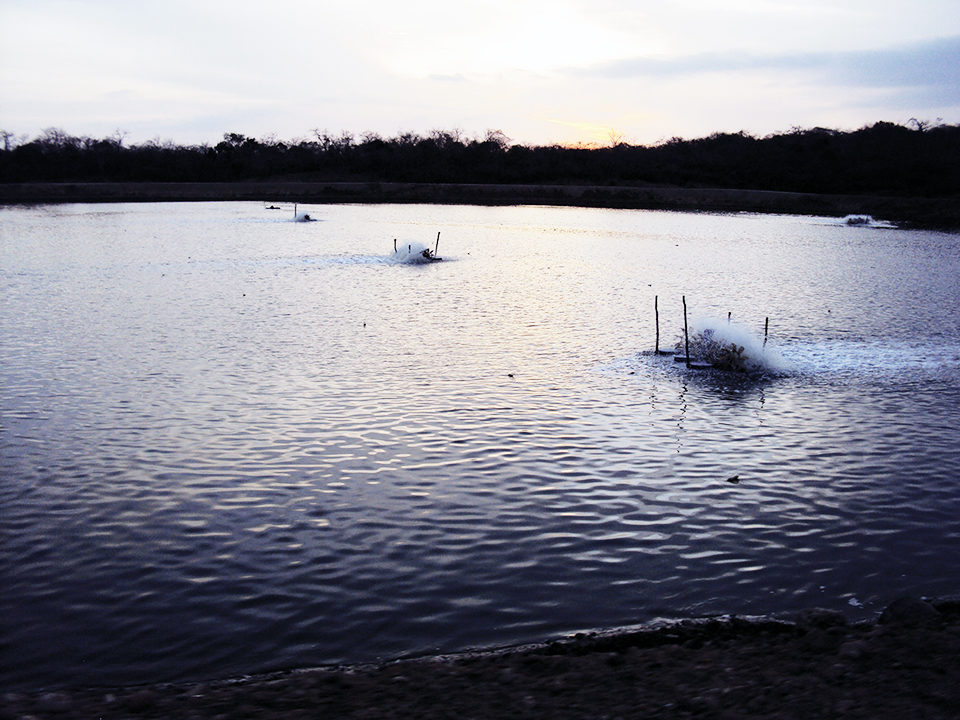
Bacterial pathogens are a major concern for commercial aquaculture. Most pathogens relevant to aquaculture are opportunistic and constitute part of the normal microflora on animal surfaces and in their guts, and in water and soil. As long as water conditions, animal health and the microflora are stable, the likelihood of opportunistic pathogens to cause disease is low.
However, when conditions change, water quality deteriorates, and animal health is compromised. Opportunists take their chance, proliferate quickly and cause infectious disease. Thus, to control the level of opportunistic pathogens, maintenance of a stable environment and water quality is crucial.
Proper management techniques are a prerequisite. In addition, measures like vaccinations and antibiotics are applied, but they also have disadvantages. Vaccines are not available for every species and disease. They are very specific to distinct diseases, mainly those viral in nature, and not effective in shrimp. The efficacy of vaccines depends on many variables, such as the immune status and size of the animal, formulation, and the administration route and regime. Additionally, vaccination is expensive, labor intensive and stressful for the animals.
In the past, antibiotics were often used for growth promotion as well as disease prevention. However, uncontrolled use of antibiotics led to a rise in resistance phenotypes among bacterial pathogens. The continuous selective pressure not only triggered resistances, but also transmission of these resistances into the environment. Consequently, the application of antibiotics as preventative measures is controversial.
Today a range of alternative products is available to improve animal health, water quality and control pathogen load. The use of beneficial bacteria, or probiotics, is one way to maintain stable conditions and prevent opportunistic pathogens from taking over.
Water quality management
Farmed aquatic animals discharge feces, urine and uneaten feed into their culture water. When this organic matter accumulates, levels of toxic compounds increase, and water quality subsequently deteriorates. Thus, excess amounts of organic matter and toxic compounds need to be removed. Bacteria can aid this process. The use of plants or microorganisms like bacteria to remove waste products is called bioremediation.
A surplus of organic matter provides excellent growth conditions for opportunistic pathogens and sets the stage for infectious disease. Beneficial bacteria such as Bacillus species mineralize organic matter and thereby help to reduce the burden.
Nitrogen compounds such as nitrite, nitrate and ammonium ions originate from decomposing waste and animal excretions. When these compounds exceed certain levels they are toxic. Ammonium ions interfere with neuronal processes, and prolonged exposure to elevated nitrite levels causes slow suffocation, especially when oxygen is limited. Although unproblematic at low concentrations, prolonged exposure to nitrate can cause weight loss and render animals susceptible to infectious disease.
To avoid such complications, beneficial bacteria are introduced to culture systems. These species perform nitrification and/or denitrification (Figures 1 and 2) and thereby lower ammonium, nitrate and nitrite levels in the water. Bacterial nitrification is the oxidation of ammonium to nitrate via hydroxyl amine and nitrite. Denitrification is the reduction of nitrate to nitrous oxide and finally to nitrogen gas, which returns into the atmosphere. Nitrite is an intermediate in both processes. To efficiently remove all three compounds, a mix of bacteria capable of nitrification and/or denitrification is advantageous.
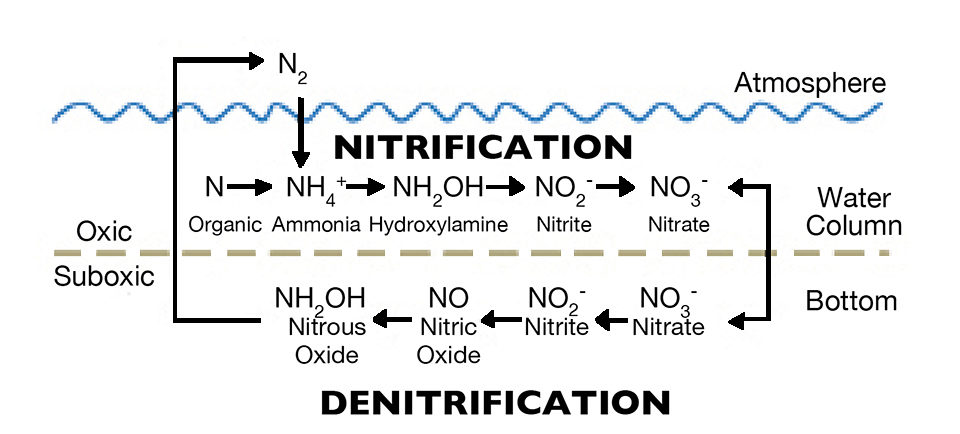
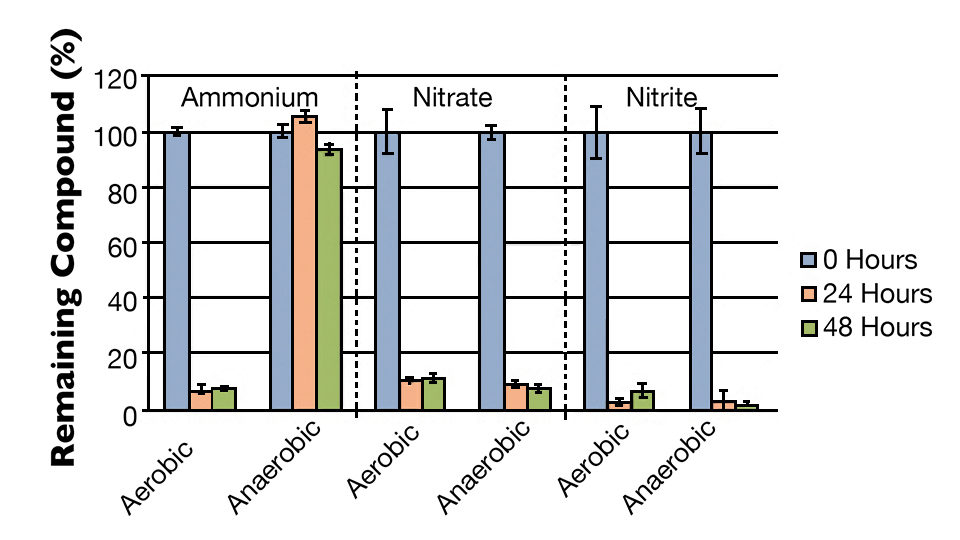
Sulfur compounds like hydrogen sulfide are another problem. Hydrogen sulfide is generated during anaerobic degradation of organic matter at the bottoms of ponds. Hydrogen sulfide interferes with aerobic respiration and thus leads to the suffocation of animals. Black sludge, which occurs when hydrogen sulfide and iron react to form iron sulfide, indicates the presence of hydrogen sulfide.
Hydrogen sulfide is used by several bacterial species. Of special interest are those in the Thiobacillus and Paracoccus genera. Thiobacillus species, for example, simultaneously remove nitrate and hydrogen sulfide in a process called sulfoxidizing denitrification and convert the compounds to non-toxic sulfate and nitrogen gas.
Beneficial bacteria versus pathogens
Pathogen antagonism is an essential feature of probiotic bacteria. In general, antagonism is achieved through competitive exclusion, which encompasses several mechanisms: production of antimicrobial substances like bacteriocins, production of organic acids that reduce pH in animals’ gastrointestinal tracts and thereby prevent the proliferation of pathogens, competition for adhesion sites and competition for nutrients.
Recently, a new approach has emerged in terms of pathogen antagonism: Disruption of quorum sensing, a bacterial cell-to-cell communication mechanism.
Bacterial talk Quorum sensing (Q.S.) describes the regulation of gene expression according to population density. Q.S. is mediated by small signal molecules that are continuously produced. As bacterial populations grow, signal molecules accumulate and upon reaching a threshold, changes in gene expression are induced.
This mechanism allows bacterial populations to coordinate group activities, such as biofilm formation, virulence and production of antimicrobials and exoenzymes. These processes put a metabolic burden on the cells and are only worth initiating when the success rate is high enough. In terms of virulence, efficient and timely expression of virulence factors ensures that the infection is successful.
Researchers have identified and isolated various kinds of signal molecules. The most common signal molecules are acylated homoserine lactones (AHL) for gram-negative bacteria and small peptides for gram-positive bacteria. Modifications such as variation in the length of the carbon side chain of AHLs confer species specificity. Independent of gram classification, numerous species respond, detect or produce the universal signal molecule AI-2.
Genera such as the Vibrios employ signal molecules that are specific for a group of related bacteria. All these molecules provide information on the environment, species composition, presence of competitors for nutrients and metabolic status of the community.
The basic system for AHL signaling consists of a synthase for AHL production and a cognate transcription factor for AHL detection (Figure 3). Upon binding of the AHL, the detector will activate/deactivate target genes. More sophisticated multichannel systems were discovered in Vibrios. Here, different signals are detected by their cognate receptors in the membrane, and a regulatory cascade activates/deactivates target genes. Each signal has a specific channel, and information from each channel is converted into the same signaling cascade.
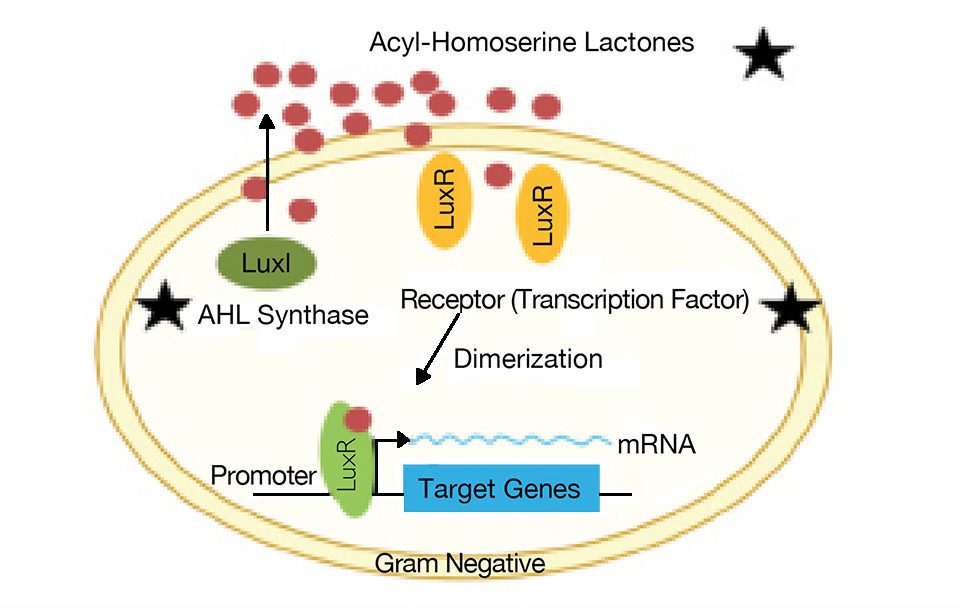
Quorum quenching
When communication is sabotaged, group activities cannot be coordinated, and traits that are regulated by Q.S. do not function properly. In the best case, quorum quenching renders bacteria less virulent and more vulnerable.
Several steps in Q.S. systems are targets for quorum quenching (Figure 3). When synthesis of signal molecules is repressed, cells are silent and unable to talk. If the target is signal detection, stability of the receptor is affected, or structurally similar molecules block access to the receptor binding site, but do not activate the receptor. Signal molecules can be destroyed by enzymatic degradation, and thus, messages never arrive at receiver cells.
Nature has already developed a variety of inhibitors produced by plants, bacteria and algae. For example, garlic contains compounds that block information flow, and the red macroalgae Delisea pulchra produces halogenated furanones that mimic signal molecules and prevent access to the receptor.
Bacteria have developed mechanisms to destroy and degrade AHLs. Several Bacillus species produce enzymes that hydrolyze the lactone ring of the AHL. Other species, like Ralstonia or Variovorax, produce enzymes that target the amide bonds of AHLs. Beneficial bacteria that not only target the growth of pathogens, but possess these enzymes can control pathogens in two ways. Growth is directly inhibited by the production of antimicrobial substances. Communication is also sabotaged to keep the pathogen under control.
Quenching systems
During the last few decades, researchers have developed a plethora of indicator strains that express traits like light production, fluorescence or pigment production in the presence of Q.S. signal molecules. These indicator strains are employed for detection but also to investigate quorum quenching. Because beneficial bacteria produce antimicrobial substances, it is important to carefully determine whether the quorum quenching effect is in fact connected to a lack of communication or whether the effect is due to growth inhibition (Figure 4).
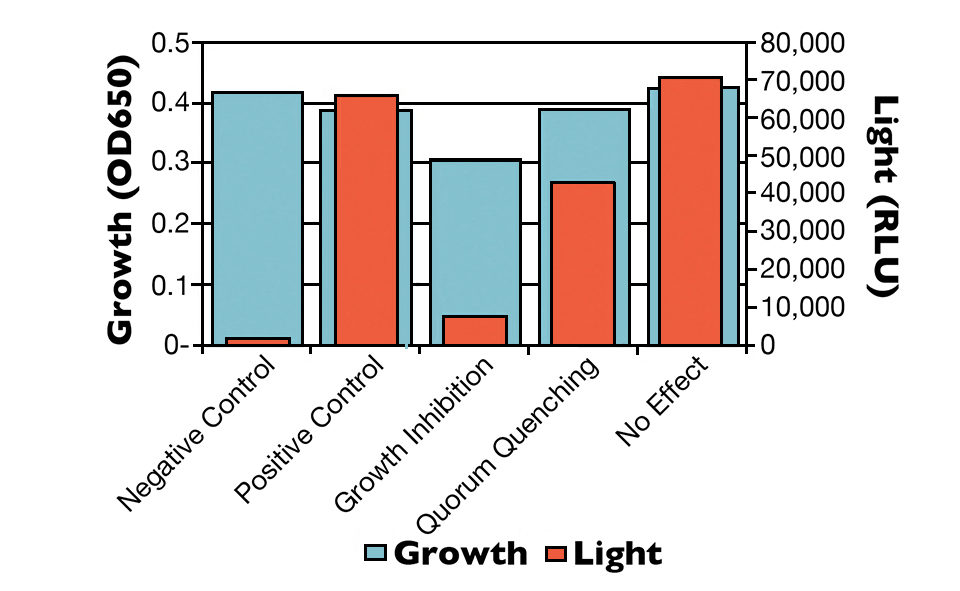
(Editor’s Note: This article was originally published in the March/April 2014 print edition of the Global Aquaculture Advocate.)
Now that you've reached the end of the article ...
… please consider supporting GSA’s mission to advance responsible seafood practices through education, advocacy and third-party assurances. The Advocate aims to document the evolution of responsible seafood practices and share the expansive knowledge of our vast network of contributors.
By becoming a Global Seafood Alliance member, you’re ensuring that all of the pre-competitive work we do through member benefits, resources and events can continue. Individual membership costs just $50 a year.
Not a GSA member? Join us.
Authors
-
Barbara Weber, Ph.D.
Biomin Research Center
AT-3430 Tulln
Technopark 1
Austria[116,101,110,46,110,105,109,111,105,98,64,114,101,98,101,119,46,97,114,97,98,114,97,98]
-
Gonçalo A. Santos, M.S.
Biomin Research Center
AT-3430 Tulln
Technopark 1
Austria -
Michaela Mohnl, D.I. M.S.
Biomin Research Center
AT-3430 Tulln
Technopark 1
Austria -
Gerd Schatzmayr, Ph.D.
Biomin Research Center
AT-3430 Tulln
Technopark 1
Austria
Tagged With
Related Posts

Health & Welfare
A comprehensive look at the Proficiency Test for farmed shrimp
The University of Arizona Aquaculture Pathology Laboratory has carried out the Proficiency Test (PT) since 2005, with 300-plus diagnostic laboratories participating while improving their capabilities in the diagnosis of several shrimp pathogens.

Aquafeeds
A look at protease enzymes in crustacean nutrition
Food digestion involves digestive enzymes to break down polymeric macromolecules and facilitate nutrient absorption. Enzyme supplementation in aquafeeds is a major alternative to improve feed quality and nutrient digestibility, gut health, compensate digestive enzymes when needed, and may also improve immune responses.
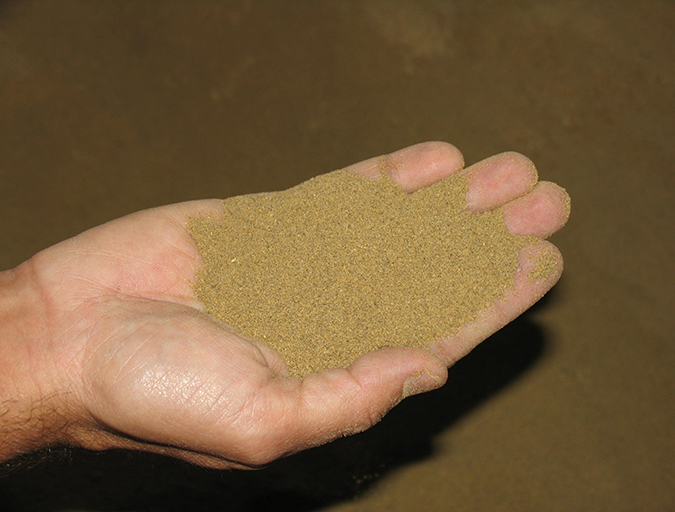
Aquafeeds
A look at the SME controlled extrusion process
A study was conducted using a Twin-Screw Extruder equipped with Specific Mechanical Energy (SME) and Density Control valves, to determine the effect of SME on the water stability of shrimp feeds. Further research is needed to evaluate the performance.
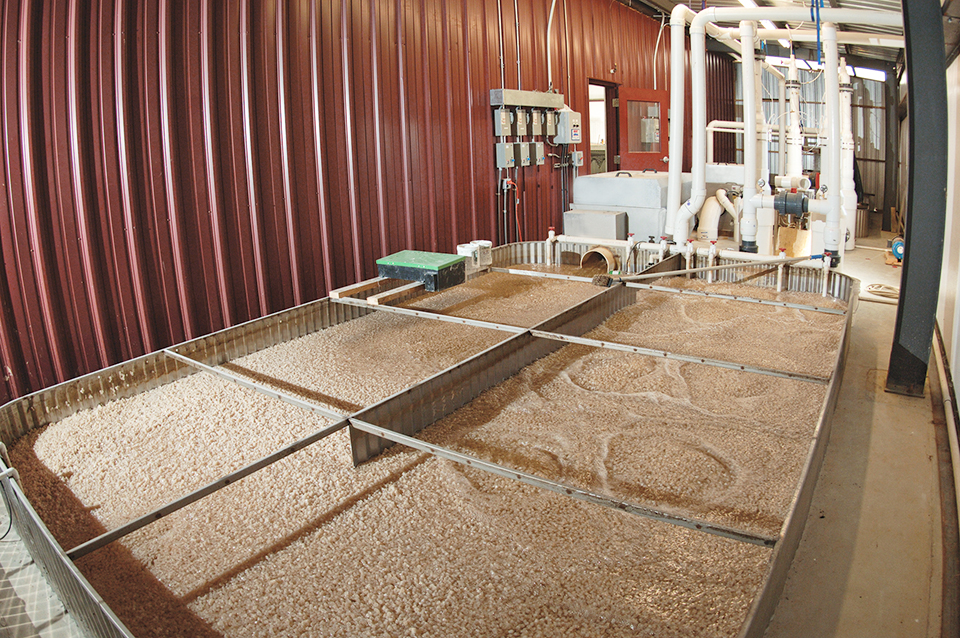
Responsibility
TAN, other water quality factors affect nitrification rates in biofilters
An important criterion when studying biofilters is the conversion rate of total ammonia nitrogen (TAN) to nitrate-nitrogen in production water. Although nitrification rates have been based on media surface areas, they do not always reflect the actual nitrification achieved. Volumetric TAN conversion rate is a direct measure based on filter volume.



